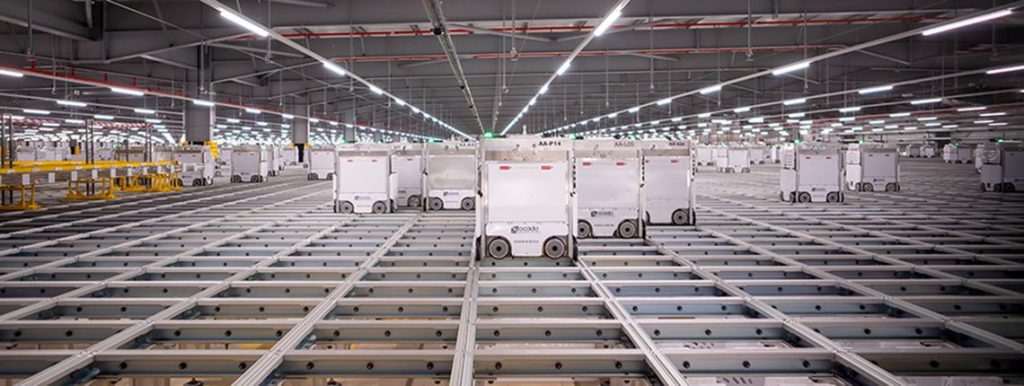Is micro-fulfilment the future of retail?

Speed and convenience are unyielding consumer demands – and the pandemic has only cemented their place in grocery sales, as online retailer Ocado has found
In the past year, nearly one in five British households has bought groceries online, totalling 5.7 million shoppers (Kantar). But online shopping services, formerly reserved for the big weekly shop, have been inundated as households have gone online for all purchases great and small. This swarm of new consumers want the convenience of popping into the local shop, and retailers have had to adapt quickly. Micro-fulfilment centres (MFCs) now support retailers with rapid home deliveries, and their numbers are increasing in the UK as they are proving especially valuable for fulfilling smaller online grocery orders. Interact Analysis predicts there will be 80 MFCs in the UK by 2023. It’s a concept quickly finding favour: Tesco is rolling out 25 in-store MFCs over the next three years, the first of which opened in West Bromwich last June.
The smaller size of these centres, which typically deliver around 4,000 orders per week, allows them to sit in urban spaces, as opposed to the huge out-of-town central fulfilment centres, which typically deliver in excess of 200,000 orders per week.
Urban MFCs mean retailers can cut the average distance between warehouse and customer to a viable minimum, allowing for both in-store pickup and rapid home delivery. At the same time, high-density urban locations provide a catchment area that maximises the number of households within reach of delivery. The cumulative impact of Covid-19 lockdowns helped Ocado achieve its highest-ever market share, thanks to industry-high sales growth of 42.2% (Kantar). Already hugely successful as a high-volume grocery delivery service, the company is keen to show it can service the convenience shopper too. Ocado’s Zoom service, launched in March 2018, offers shoppers a 60-minute delivery if they are within a 5km radius of its dedicated warehouse in Acton, west London.
It offers a choice of 10,000 items and a minimum spend of just £15, compared to the main store’s minimum of £40. With its standalone website and app, it is playing in a market that includes Sainsbury’s Chop Chop, Waitrose Rapid Delivery, UberEats, Deliveroo, Just Eat, Co-op, Amazon Fresh, and a growing range of start-ups.
At 930m2, the Zoom Acton site is considerably smaller than the customer fulfilment centre now being built in Bristol within a 14,000m2 warehouse, and is dwarfed by the 146,000m2 Erith hub in southeast London.
Single supply channel
George Dean, head of Ocado Zoom, says: “Ocado has developed a range of different sized automated sites that enable us to serve the whole range of reasons that customers shop for groceries online, with positive economics. For instance, some consumers want to shop for groceries online, but don’t want to spend the minimum order value or find committing in advance to the timing of a delivery inconvenient. Smaller sites like micros allow us to be closer to those customers and reduce delivery times from days to minutes. We are also able to link them to our wider fulfilment network of large sites, which improves their efficiency.”
The Acton unit is packed out with the same automation technology as other, larger facilities, making it “really efficient, low-cost to serve and allows us to have a really dense product range in a small space,” Dean says. He adds that 55% of customers have been topping up between bigger shops. Snacks and confectionery are popular via the app, but the biggest sellers are fresh vegetables such as cucumbers and avocados. “Our customers want things right now. But we don’t want our shoppers to have to compromise. We want them to get what they want, when they want it.”
Zoom’s 10,000 product lines are sourced from the main Ocado distribution centre in Hatfield and taken to Acton once a day, meaning the service effectively only has one ‘supplier’.
“Potentially we can open up these Zoom sites in really tight urban locations and only have to deal with one delivery a day,” notes Dean, who adds the service takes the quantity it wants – not whole cases – allowing for a wide range of SKUs but without the typical depth of holding required by major supermarkets. “If we only have two of an item and we sell one today, we bring down one tonight and it can be in full stock for the next morning.”
For the procurement team, this has meant thinking in terms of convenience as opposed to volume, in order to capture the “right here, right now”, shopper.
“Most products available on Ocado Zoom are also available on Ocado,” says Dean, “so for our buyers it just means more volume and no great change. However, we also need buyers to source products such as single-serve bottles of water and food-on-the-move items like fresh sandwiches that aren’t listed on Ocado.com.”
Top-up shops
Dean believes supplier brands should develop specific strategies for the accelerating micro-fulfilment category, suggesting they consider the size and shape of packaging to ensure they give themselves a greater chance of prospering in the emerging channel, which relies on smaller vehicles and bikes to fulfil goods.
Last-mile logistics provider, DPD-owned Stuart, is a delivery partner. Its fleet of bikes, mopeds and cars meet a weekly target of ensuring 95% of orders are delivered within an hour. Stuart’s technology is integrated into the Zoom app, enabling consumers to track their order from point-of-purchase to arrival.“This channel is a new way to serve customers in the most convenient way,” Dean explains.

